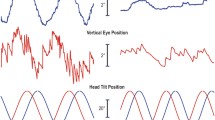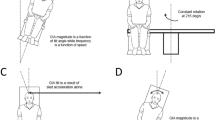Summary
Off-vertical axis rotation in darkness induces a perception of body motion which lasts as long as rotation continues. Perceived body motion is the combination of two simultaneous displacements. The most easily perceived is a translation without rotation along a conical path, at the frequency of the actual rotation. Meanwhile, the subjects feel as if they were always facing towards the same direction. The summit of the cone is generally below the head, from the waist to below the feet, and subjects have a sense of progression in the direction opposite to actual spinning. Some subjects feel, on the contrary, the summit of the cone above their heads, and the progression in the direction of spinning. Subjects also perceived another body motion, although it was faint for some of them. It consists of a rotation at low velocity in the same direction as progression along the cone. The axis of the cone is perceived as slowly rotating along a larger cone. These motion perceptions increase with tilt angle and rotation velocity. They probably result from the analysis by the Central Nervous System of the acceleration acting on the otoliths. The perceived trajectory would be reconstructed from estimates of gravity, and kinematic variables such as head translational acceleration and velocity, and head rotational velocity. The same variables would account for OVAR-induced nystagmus. Motion sickness would result from the impossibility of reconstructing a consistent body movement from most sets of values of these variables.
Similar content being viewed by others
References
Benson AJ (1974) Modification of the response to angular accelerations by linear acceleration. In: Kornhuber H (ed) Handbook of sensory physiology, Vol VI/2. Springer, Berlin Heidelberg New York, pp 281–320
Benson AJ, Barnes GR (1973) Responses to rotating linear acceleration vectors considered in relation to a model of the otolith organs. In: 5th symposium on the role of the vestibular organs in space exploration. NASA SP 314: 221–36
Benson AJ, Bodin MA (1966) Interaction of linear and angular accelerations on vestibular receptors in man. Aerosp Med 37: 144–154
Benson AJ, Diaz E, Farrugia P (1975) The perception of body orientation relative to a rotating linear acceleration vector. Fortschr Zool 23: 264–274
Berthoz A, Droulez J (1982) Linear self motion perception. In: Wertheim, Wagenaar, Leibowitz (eds) Tutorials on motion perception. Plenum Press, New York, pp 157–199
Buizza A, Leger A, Droulez J, Berthoz A, Schmid R (1980) Influence of otolithic stimulation by horizontal linear acceleration on optokinetic nystagmus and visual motion perception. Exp Brain Res 39: 509–522
Denise P (1986) Rotation d'axe incliné par rapport la gravité. Effet des petits angles. Thèse de Médecine. Université Paris 6
Droulez J (1986) Les fonctions otolithiques chez l'homme. Thèse de Médecine. Université Paris 7
Epstein LI (1977) On the interaction of otolithic and angular sensations. Aviation Space Environ Med 48: 200–202
Guedry FE (1965) Orientation of the rotation axis relative to gravity: its influence on nystagmus and the sense of rotation. Acta Otolaryngol (Stockh) 60: 30–48
Guedry FE (1970) Effects of concomitant stimulation of the semicircular canals and otoliths by “barbecue spil” rotation about a tilted axis and other forms of stimulation. Excerpta Med Int Congr Ser 206 Amsterdam
Guedry FE (1974) Psychophysics of the vestibular sensation. In: Kornhuber H (ed) Handbook of sensory physiology, Vol VI/ 2. Springer, Berlin Heidelberg New York, pp 3–154
Guedry FE, Harris CS (1963) Labyrinthine functions related to experiments on the parallel swing. Report. NSAM 86. Pensacola, Fla., Nav. Sch. Aviat. Med
Lackner J (1985) Human sensory-motor adaptation to the terrestrial force environment. In: Ingle D, Jeannerod M, Lee D (eds) Brain mechanisms and spatial vision. NATO Series. Nijhoff, Dordrecht, pp 175–209
Lackner JR, Graybiel A (1978) Some influences of touch and pressure cues on human spatial orientation. Aviat Space Environ Med 49: 798–804
Lackner JR, Graybiel A (1979) Parabolic flight: loss of sense of orientation. Science 206: 1105–1108
Leger A, Landolt JP, Money KE (1980) Illusions of attitude and movement during earth-horizontal rotation. NATO Conference Proceedings 287 B7: 1–9
Mayne R (1974) A system concept of the vestibular organ. In: Kornhuber H (ed) Handbook of sensory physiology, Vol VI/ 2. The vestibular system. Springer, Berlin Heidelberg New York, pp 493–580
Meiry JL (1965) The vestibular system and human dynamic space orientation. Thesis. M.I.T. Cambridge, Massachusetts
Miller EF, Graybiel A (1973) Perception of the upright and susceptibility to motion sickness as functions of angle of tilt and angular velocity in off-vertical rotation. Report NAMRL, Pensacola Fla.
Mittelstaedt H (1975) On the processing of postural information. Fortschr Zool 23: 128–141
Ormsby CC, Young LR (1976) Perception of static orientation in a constant gravito-inertial environment. Aviat Space Environ Med 47: 159–164
Stone R, Letko W (1969) Some observations during weightlessness stimulation with subject immersed in a rotating water tank. NASA TN D2195
Author information
Authors and Affiliations
Rights and permissions
About this article
Cite this article
Denise, P., Darlot, C., Droulez, J. et al. Motion perceptions induced by off-vertical axis rotation (OVAR) at small angles of tilt. Exp Brain Res 73, 106–114 (1988). https://doi.org/10.1007/BF00279665
Received:
Accepted:
Issue Date:
DOI: https://doi.org/10.1007/BF00279665




